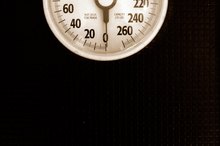Does Weightlifting Stimulate Bone Growth?
Think of a bone in your body like a wooden stick -- the larger and denser the stick, the harder it is to break. As you age, however, the hormones that signal your body to build bone start to diminish in production, which can make your bones less dense and more injury-prone. By eating a diet rich in calcium and vitamin D and engaging in weightlifting exercises, you may be able to stimulate bone growth. Always speak to your physician before beginning a weightlifting program.
Mechanics
Two factors can stimulate bone growth in your body: hormone triggers and when your muscles pull on your bones. The changing hormones help your bones grow longer and stronger as you progress into adulthood. Bone growth stimulation from your muscles has more to do with a protective measure for your body. When you lift weights, your muscles pull on your bones, and your bones must support the added weight. To ensure your body can support future weightlifting sessions, your body builds new bone cells so your bones can become stronger.
- Two factors can stimulate bone growth in your body: hormone triggers and when your muscles pull on your bones.
- Bone growth stimulation from your muscles has more to do with a protective measure for your body.
Bone Mineral Content Study
Exercise and Unclogging Heart Arteries
Learn More
The Department of Health Sciences, University of Jyväskylä, Finland, conducted a research review of bone density studies to determine weightlifting’s effectiveness in building bone mass. According to the study, published in the April 2006 edition of “Aging Clinical Experimental Research,” weightlifting has the greatest impact on young people and adults under age 60, resulting in bone mass gains of 2 to 5 percent per year. For those ages 60 and older, typical bone mass increases from weightlifting were between 1 and 3 percent. The study did note, however, that lifting weights offered additional benefits related to bone health, such as a reduced risk for falls that could potentially result in bone fractures.
- The Department of Health Sciences, University of Jyväskylä, Finland, conducted a research review of bone density studies to determine weightlifting’s effectiveness in building bone mass.
Weightlifting vs. Weight Bearing
Weightlifting implies the motion of moving a free weight or weighted machine to build muscle and build bone. This will build bone, just as weight-bearing exercises, such as jogging, dancing and racquet sports, will. If you are hoping to adopt an exercise routine that can improve your bone mass, you can alternate weightlifting sessions with weight-bearing exercises, as well. Unless you are training and lifting weights competitively, it’s best to lift weights every other day to minimize your risk for injury.
- Weightlifting implies the motion of moving a free weight or weighted machine to build muscle and build bone.
- If you are hoping to adopt an exercise routine that can improve your bone mass, you can alternate weightlifting sessions with weight-bearing exercises, as well.
Warning
How Diet & Exercise Affect the Skeletal System
Learn More
When your bones lose density, you are at risk for experiencing a condition known as osteoporosis. While weightlifting can encourage bone growth and reduce your risk for osteoporosis, weightlifting alone isn’t considered enough to prevent or cure osteoporosis. For this reason, talk to your doctor about the variety of physical activity and nutrition choices you can make to strengthen your bones.
Related Articles
References
- Aging Clinical and Experimental Research; Muscle Training for Bone Strength
- University of New Mexico: Resistance Training and Bone Mass
- Soliman A, De Sanctis V, Elalaily R, et al. Advances in pubertal growth and factors influencing it: Can we increase pubertal growth?. Indian J Endocrinol Metab. 2014;18(Suppl 1):S53-S62. doi:10.4103/2230-8210.145075
- National Osteoporosis Foundation. Peak bone mass.
- Levine MA. Assessing bone health in children and adolescents. Indian J Endocrinol Metab. 2012;16(Suppl 2):S205-S212. doi:10.4103/2230-8210.104040
- Bielemann RM, Martinez-Mesa J, Gigante DP. Physical activity during life course and bone mass: a systematic review of methods and findings from cohort studies with young adults. BMC Musculoskelet Disord. 2013;14:77. doi:10.1186/1471-2474-14-77
- National Osteoporosis Foundation. Get the facts on calcium and vitamin D.
- National Institutes of Health. Vitamin D fact sheet for consumers. Updated March 24, 2020.
- Demontiero O, Vidal C, Duque G. Aging and bone loss: new insights for the clinician. Ther Adv Musculoskelet Dis. 2012;4(2):61-76. doi:10.1177/1759720X11430858
- The North American Menopause Society. Are we there yet? Navigate now with our guided menopause tour.
- Manolagas SC, O'Brien CA, Almeida M. The role of estrogen and androgen receptors in bone health and disease. Nat Rev Endocrinol. 2013;9(12):699-712. doi:10.1038/nrendo.2013.179
- Bass MA, Sharma A, Nahar VK, et al. Bone mineral density among men and women aged 35 to 50 years. J Am Osteopath Assoc. 2019;119(6):357-363. doi:10.7556/jaoa.2019.064
- Dietary reference intakes for adequacy: calcium and vitamin D. In: Dietary Reference Intakes for Calcium and Vitamin D. Ross AC, Taylor CL, Yaktin Al, et al., editors. Published 2011.
- Alswat KA. Gender disparities in osteoporosis. J Clin Med Res. 2017;9(5):382-387. doi:10.14740/jocmr2970w
- National Osteoporosis Foundation. Just for men.
- National Osteoporosis Foundation. Smoking and bone health.
- National Council on Aging. Falls prevention facts.
Writer Bio
Rachel Nall began writing in 2003. She is a former managing editor for custom health publications, including physician journals. She has written for The Associated Press and "Jezebel," "Charleston," "Chatter" and "Reach" magazines. Nall is currently pursuing her Bachelor of Science in Nursing at the University of Tennessee.








